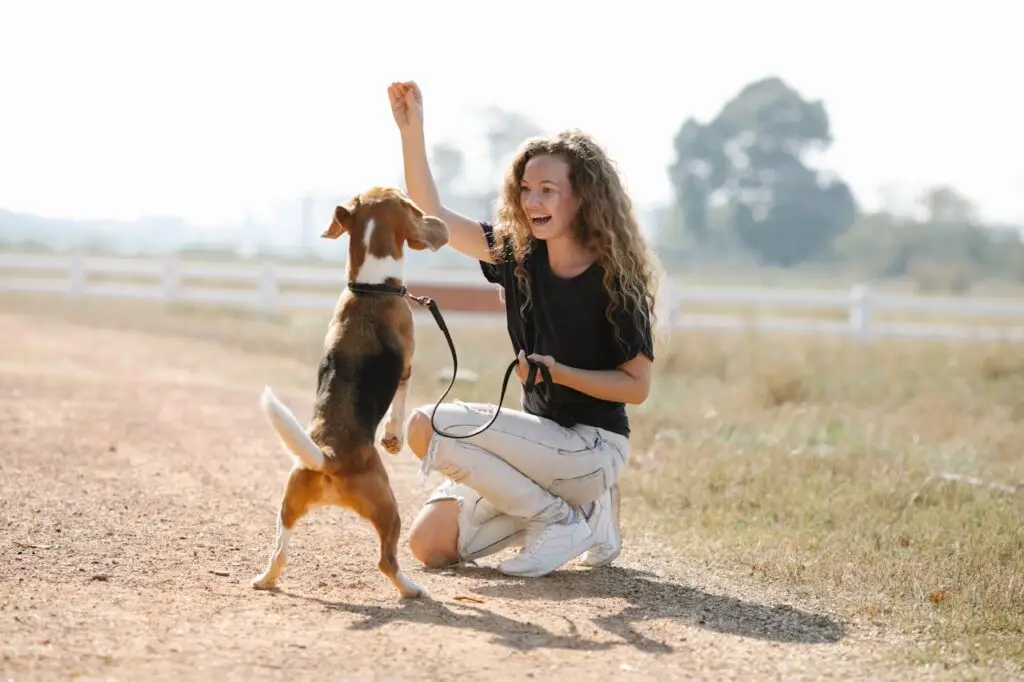
Why Is Your Dog Barking?
Woof woof! Dogs have a lot to talk about, and barking is their preferred method of communication. But let’s face it, excessive barking can be a sign that something’s not quite right in their doggy world. Don’t worry, though, there’s a solution! A certified dog trainer can help you get to the bottom of the different types of barking and give you some top-notch advice on how to keep your pooch happy and relaxed. Embrace the bark, and your furry best friend will be wagging their tail in no time!
Alarm Barking
Dogs have a natural watchdog instinct, so what do they do when they hear or sense something out of the ordinary? They bark their little heads off, of course! This dog barking is called alarm barking. It’s an emotional response, meaning your pup has no control over it. But fear not, with some clever tactics, you can change the way your dog perceives. By doing this, the stimulus will no longer effect and reduce their tendency to bark excessively. Stay tuned for how to do just that!

Demand Barking (or Whining)
Dogs have a natural tendency to bark or whine when they need something from their human companions. This behavior, commonly known as demand barking, can sometimes become excessive and can be a challenge for pet owners to deal with. If a dog learns that they can get what they want by barking persistently, they will continue to do so. However, there are effective ways to stop this behavior. The first step is to ignore the barking and not give in to the dog’s demands. Over time, the dog will learn that this behavior does not work and will stop using it to get what they want. It may require some patience and consistency, but it is worth it to have a well-behaved and obedient furry companion.
Over-Stimulated or Anxious Barking?

Is your pup bouncing off the walls? Can’t handle the excitement? Must be all those triggers in their environment – the frustration, the worry! And let’s not forget those excessive barks. Could it be over-stimulation or anxiety? Fear not, my fellow dog lovers! Doggie decompression is the answer. Freedom is restrained until they calm down. It’s time to train your furry friend to chill, and we’ve got you covered in this article.
Boredom or Distress Vocalizations - Persistent Barking When Left Alone

Persistent barking when left alone can mean boredom or anxiety. Help by bringing your pup in or increasing exercise with a walk or dog walker. Separation anxiety requires a certified dog trainer. Exercise and crate training won’t solve the problem.
Varied Barking Needs Varied Training Techniques
Understanding the underlying causes of the array of barking behaviors that a dog or puppy exhibits plays a big part in successfully curbing them. We will do our best to explain the different methods available based on the type of barking that needs to be addressed.

Alarm Barking: Training Your Dog Not to React to Everyday Sights and Sounds
The way a dog guardian responds to alarm barking plays a major role in how a dog or puppy learns to feel about everyday stimuli experienced in the home and neighborhood. Since alarm barking is rooted in protective instincts, how a guardian reacts to alarm barking will inform their dog or pup how to feel about whatever stimulus has caused them to bark.
It’s up to the human, then, to help their canine distinguish the difference between everyday occurrences (like the neighbors coming and going) and unusual activity (like someone breaking into the house) that they WILL want their dog or puppy to alert them to.

Stay Calm if You Want Your Dog to Respond Calmly
Reducing a dog’s barking takes patience and a concerted effort on the part of guardians. Rather than simply trying to stop the barking through yelling or shushing, guardians need to guide their dog’s responses to different stimuli. Dogs don’t understand that their barking is causing frustration for their human companions, and in fact, may become even more excited by these reactions. A better approach is for guardians to remain calm and soothe their dog, helping them to learn how to recognize and ignore non-threatening noises through a process of habituation. By repeatedly exposing dogs to different sounds and allowing them to gradually acclimate to these stimuli, guardians can help reduce barking and improve their dog’s overall behavior – a process that requires patience, persistence, and a willingness to work with their furry friend over time.
Using Massage to Calm a Dog Down
When a dog or puppy is alarm barking, the first step is to recognize the reason for their bark. It could be due to a sudden noise, an unfamiliar scent, or feeling anxious. Once you have identified the trigger, take some time to calm your furry friend. One effective way to do this is by gently massaging your dog’s back, neck, and head in slow circular motions. This stimulates an immediate relaxation response and lets your dog know they are safe and loved. It also signals to them there is no need to worry about the stimulus that caused the barking. Additionally, you can try using calming aromatherapy oils such as lavender or chamomile in your dog’s environment. These can reduce stress and anxiety and help recondition their brain to accept the stimulus as non-threatening over time. Remember, patience and consistency are key when training your dog. Positive reinforcement and gentle encouragement will go a long way in helping them overcome alarm barking and other unwanted behaviors. With a little effort and care, you can build a stronger bond with your furry companion and enjoy a happier, more peaceful home.

Using Food To Calm A Dog Down
Treat your furry friend with some scrumptious snacks to turn that frown upside down! Food not only soothes their stomachs but also calms their heart rate – perfect for reversing negative associations. But if your pup has a stubborn refusal to something, maybe try a massage instead.
Applying a Consequence to Unwanted Barking
Are you struggling to manage your furry friend’s barking? It’s time to initiate the timeout game! Allow them a brief break from their ongoing barking and let them realize that excessive barking is not an effective way to make friends. With consistent training and swift action, you can impart a significant lesson to your beloved pet that they will remember for a lifetime!
Demand Barking and Whining: Stop Reinforcing the Behavior by Taking Your Attention Away from Your Dog
Demand barking and whining is learned behavior that dogs use to get attention from their guardians. Humans often give in and reward this behavior, reinforcing it. To stop it, ignore your dog and progressively withdraw attention using the “3 Strikes, You’re Out” rule. If that doesn’t work, restrict your dog’s freedom until they calm down.

Over-Stimulated and Anxious Barking: Using Crates, Gates, and Tethers to Calm a Dog or Puppy Down
Overstimulated dogs may become over-aroused, which can result in a flurry of frenzied behavior. This can sometimes manifest as excessive barking, lunging, and other signs of distress. It’s important to note that some dogs may exhibit this behavior due to strong guarding instincts while others may simply become overwhelmed by the stimulation around them. In such cases, it is essential to remove the dog from the situation and utilize doggy decompression training techniques to help calm them down.
One helpful technique is to engage the dog in activities that encourage relaxation, such as gentle massages and soothing music. Additionally, providing the dog with a quiet and comfortable environment to decompress and unwind can also be beneficial. It’s also important to remember that each dog is unique and may require a different approach when it comes to decompression training. Carefully observing your dog’s behavior and adapting your methods accordingly is key to helping them feel more relaxed and content. By taking the time to show your furry friend the care and attention they need, you can help prevent over-arousal and ensure their overall well-being.
Boredom or Panic-Related Barking
If your dog barks excessively when alone, it’s because they’re bored or have separation anxiety. To fix boredom, give your dog more attention with activities like training, walks, and new adventures. Try getting professional help from dog walkers or daycare if needed. If your dog shows symptoms like pacing, drooling, or destructive behavior when you leave, they likely have separation anxiety. Don’t worry, you can address it with professional help.
Discouraging Barking is Possible, but Not Completely Stopping It
Knowing how to respond to the different types of barking that a dog or puppy exhibits can go a long way towards reducing the amount of barking they do. However, it’s not possible to eradicate barking altogether – a certain amount of barking is normal and to be expected. If your dog or puppy barks a lot, try to examine the root cause of the barking and respond accordingly. Alarm barking is an easy fix when a dog guardian makes a commitment to consistently calming their dog or puppy down around common triggers, and demand barking can be solved really quickly, too, by no longer responding to it.

If your dog or puppy’s barking has become a problem, however, and you are at a loss about what to do about it, seeking help from a certified dog trainer—one who uses science-based methodology to solve behavior problems and NOT aversive techniques—is a good idea.

